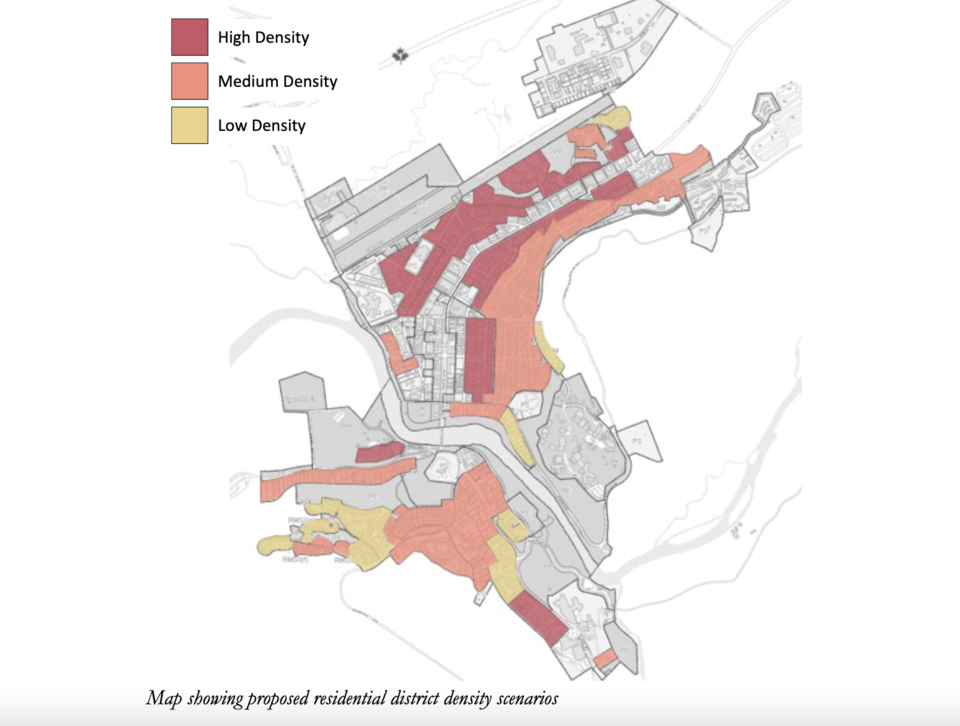BANFF – Plans to increase residential density throughout the Banff community to deal with the ongoing housing crunch are one step closer to reality.
Council will consider first reading on Monday, (March 25) of a land use bylaw amendment to increase residential density – often a contentious discussion in Banff – with a fundamental shift in philosophy centred around the number of dwellings on a site, rather than the form those dwellings take.
Dave Michaels, manager of planning services for the Town of Banff, said the proposed bylaw simplifies and standardizes the land use bylaw requirements for all residential development while increasing opportunities for those wishing to create new housing.
“Through the proposed approach, the difference between existing requirements and proposed requirements will vary between districts, with some experiencing more change than others,” he said.
Currently, Banff’s 23 residential land use districts all have different development requirements.
The proposal would retain the existing districts, with some proposed boundary adjustments, but would apply the same development regulations for districts in the same density categories of high-, medium- and low-density.
Michaels said the proposed changes have been developed to provide greater flexibility for various housing types, noting the fundamental shift in philosophy centres around the number of dwellings on a site, rather than the form those dwellings take.
While this could lead to a change in the neighbourhood character in other communities, he said this is less of a concern in Banff where there is already a range of housing types in most neighbourhoods, specifically multi-family housing.
“Our neighbourhoods already have a high degree of social diversity that is partly a result of a range of housing types,” said Michaels in a report going to council on March 25.
The proposals include increasing the maximum allowable floor area for a development based on the number of units provided on a site, rather than building form.
Another overall change proposed is removal of maximum site coverage requirements in residential districts in favour of minimum landscaping requirements.
Currently, the lowest density districts allow for duplex housing with two accessory dwellings for a total of four units, while one of the biggest changes would be lowest density districts will allow for four-plex housing.
In terms of density, the maximum floor area that can be constructed on a site is based on the total number of homes proposed rather than the form, with more floor area allowed when more homes are provided.
Under the proposals, setbacks would be standardized across all residential districts, while the maximum building height in the high-density districts would increase from a current maximum of 11.5 metres to 14.5 m, which is approximately four storeys.
“It is worth noting that prior to 1992, the maximum building height was 14 metres,” said Michaels.
A number of other changes are proposed to simplify and increase residential development potential, including removal of existing limits on the minimum and maximum size of accessory dwellings.
In addition, the proposed changes would allow accessory dwellings to be contemplated in triplex and fourplex housing, as well as duplex and single-detached housing. Currently, accessory dwellings are limited to single-detached and duplex housing.
Mayor Corrie DiManno said Banff has hit a flatline in terms of new housing development in recent years, noting there is a housing shortfall in the community of between 700 to 1,000 housing units.
“Space is absolutely precious in Banff and so moving into the future we need to be building as sustainably, efficiently and as high density as possible,” she said.
“We’re carefully reviewing where we could handle more density in town. Density already exists here in Banff, this is not new for Banff, this is simply taking density to the next level.”
The mayor pointed to Banff’s near zero rental vacancy rate in the last few years and ongoing high costs of home ownership.
“We know that we have a shortfall of up to 1,000 units, we know there’s overcrowding happening in our community and we also know that rents are very unattainable,” said DiManno.
“By being able to put more supply into the market, I am hopeful that will help address all of those issues.”
Council has been tackling housing with construction of the Ti’nu affordable rental apartments, The Aster for-ownership complex and other housing projects under investigation, but DiManno said the Town of Banff needs to work with the private sector to solve the housing crunch.
“Council has heard very loudly from the private sector that they want to do their part and we need to enable the conditions through policy to help them be successful in building more housing,” she said.
Michaels said amending the land use bylaw to increase residential density is one of five housing initiatives listed in the federal Housing Accelerator Funding agreement, with Banff getting $4.6 million over the next three years.
“Receiving funding is tied to achieving all five approved initiatives, as well as issuing permits for 240 new homes in Banff prior to Jan. 29, 2027,” he said.
If first reading of the bylaw to increase residential density passes next Monday, a legally-required public hearing on the matter would be held June 10.
That date is also set for public hearings on separate bylaw amendments to eliminate minimum parking requirements for residential development and amending residential land use districts.




